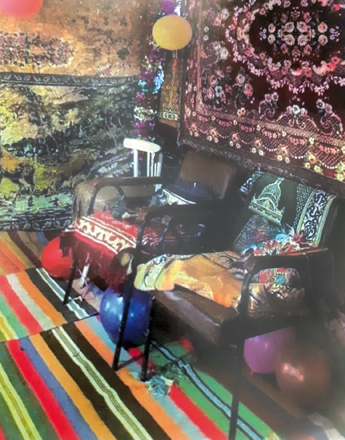You are here
New book spins a tale of carpet weaving’s multifaceted role in society
By Saeb Rawashdeh - May 18,2023 - Last updated at May 18,2023

Catreena Hamarneh (Photo courtesy of GPIA)
AMMAN — Exploring the social and symbolic meaning of carpets, the new book “Woven Heritage” delves into the significant role that the rugs played throughout the history of the region.
Speaking during the book launch held at the German Protestant Institute of Archaeology (GPIA) on Tuesday, author Catreena Hamarneh said that carpet weaving has been an important social event, noting that carpets were traditionally parts of dowries that were given from generation to generation.
“In reality, carpets have several connotations, several meanings. For some, they are just decoration. They could be something magical, something unusual. We all remember Sinbad’s story with a magical carpet,” Hamarneh said.
In 2019, the staff of GPIA found a heap of the carpets, inspiring Hamarneh to write the book.
The GPIA has three categories of carpets: Local, regional and oriental. These carpets came from Jordan, Egypt, Kurdistan, Iran and Azerbaijan, she said.
“Carpet belt is a term used to describe the area of the Middle East from Morocco to Egypt, Palestine, Jordan, Syria, Turkey, Iraq, Iran, Central Asia, Afghanistan all the way to India and China,” Hamarneh said.
She noted that one of the biggest problems in tracing the heritage of carpet weaving is oral tradition, as “unfortunately, the written records are scarce and scholars lack books and catalogues”.
In order to prepare a book, Hamarneh conducted interviews with carpet collectors, weavers and experts, also searching the archives of the Ministry of Culture.
Although a small country, Jordan has a variety of carpet styles, Hamarneh said, noting that in Ramtha, a typical carpet called Zare — originally from Syria and northern Jordan — is created to be thicker due to the colder weather in the north of the country.
“They look like banners,” Hamarneh added.
In the eastern parts of Jordan, there is a long, colourful type of carpet called Mafrash used in decoration for different tents, she said.
“In the south-eastern part of Jordan, camel hair is more commonly used in carpet weaving,” Hamarneh said, adding that in central Jordan there are small, striped carpets known as Fijje used in small towns.
Carpet weavers came to Salt from Syria in the 19th century and early 20th century, creating a new typology of carpets, she said, adding that modifications of the design of carpets took place over time.
“New dyes and synthetics appeared in the 1940s and 1960s,” Hamarneh said, adding that recently, computers have been used to create new patterns.
Vertical looms are often used in Syria and Palestine, while the Jordanian tradition typically uses the pedalled loom that came with Syrians to Salt in the late 19th century, Hamarneh said.
“Today, seated looms are more popular than the ground looms among female weavers,” Hamarneh said.
Related Articles
AMMAN — Regional migrations contributed to merging of different styles of handicrafts and carpets, noted Catreena Hamarneh from the German P
“Jordanian weaving is the work of artists. It is something to be fully experienced. You must see it, touch it, feel it and live with it. These pieces are so beautiful it is sometimes hard to imagine they were made for hard use.”
Fascinated by the paradoxical simplicity and complexity of traditional bedouin weaving, one Jordanian art collector has taken it upon himself to preserve the dying art.



















